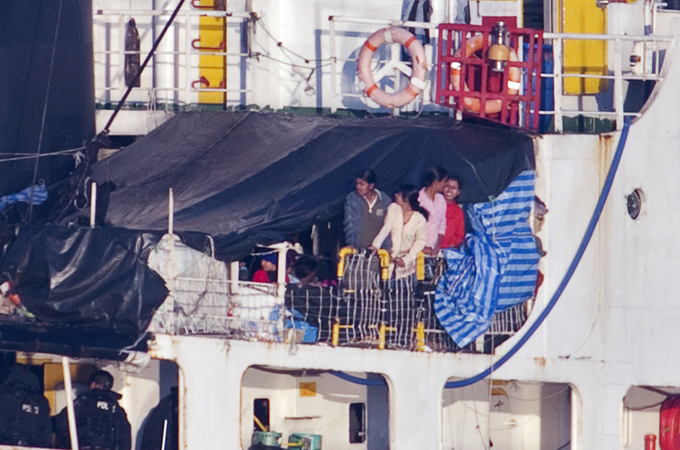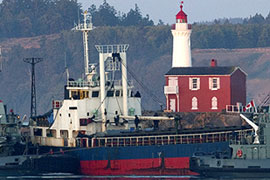A hardening of the Canadian heart
Is public opinion swinging against Canada’s historically fair immigration policy?

 |
| The arrival of almost 500 Tamil refugees has split Canadian public opinion [REUTERS] |
The debate over immigration policy has already taken a hard right turn in Australia after boatloads of Sri Lankan Tamils washed up on its shores. Canada – where nearly 500 Tamils came ashore last week – appears set to follow, with 63 per cent of Canadians saying the leaky boat should never have been given safe harbour.
The charge against these recent arrivals is being led by Stephen Harper, Canada’s prime minister, with the rest of the country more than happy to toe the piper’s line.
“Let me be clear. We are a land of refuge but, at the same time, I think Canadians are pretty concerned when a whole boat of people comes – not through any normal application process, not through any normal arrival channel – and just simply lands,” Harper said this week.
Refugee nation
But, Canada – which has a reputation for taking in more of the persecuted and oppressed than almost any other refugee-accepting nation – has not so far chosen to abandon its humanitarian impulse. It receives 34,000 asylum seekers every year, most of them arriving the way they presumably should – by air, using fake documents and all manner of deceit.
As Walter Lippmann, the famous scholar of public opinion, said nearly a century ago: “In really hard times the rules of the game are altered. The inchoate mass begins to stir. It becomes potent, and when it strikes … it strikes with incredible emphasis.”
And, strike it has on Canada’s immigration and refugee system.
There is no denying that these are hardscrabble times for many, and although Canadians are better off than people almost anywhere else on this planet, they are loathe to accept what they see as an alien invasion of refugees – even if they are a bedraggled, vanquished lot fleeing the torment of a triumphalist Colombo government.
The question, therefore, is whether this boatload of Tamils – the second to arrive in Canada since last October – represents a desperate desire for survival or a diabolic attempt on the part of shadowy figures to rekindle the embers of a rebellion in Sri Lanka that was crushed last year.
Hence, Ottawa’s insistence that it must first establish the identities of each one of the 492 men, women and children, and then, confirm beyond doubt that they have no links or affiliation with the Tamil Tigers, a banned terrorist organisation in Canada.
Diaspora politics
Two factors have led a majority of Canadians to favour turning the Tamils away.
Historically, dating back to the outbreak of World War I, boats carrying Sikhs, Jews or Chinese have always met with an almost irrational hysteria, orchestrated by the Liberal and Conservative governments of the day.
 |
| Ottawa wants to confirm that the migrants are not associated with the Tamil Tigers [REUTERS] |
As recently as 1987, Brian Mulroney, the then prime minister, called parliament back from its summer recess to debate the fallout from the arrival of a boatload of Sikhs from India. The heated rhetoric centred on the possibility that Canada was becoming a haven for those fighting for an independent “Khalistan” carved out of India.
The second factor is a fallout from the so-called Khalistan phenomenon. There resides in the minds of many Canadians the rather far-fetched idea that the Tamils may set up a government-in-exile in Toronto, which is already home to most of the 400,000-strong diaspora living in Canada.
Just as Khalistan continues to raise its ugly head every so often in Canada, Eelam too could become a rallying cry, or so it is feared.
Politicians of all stripes have distanced themselves from the Tamils in recent years largely because the community has trouble distinguishing itself from the cold-blooded struggle that was waged by the Tigers in Sri Lanka.
None of this, though, may have any influence on the fates of the 492 Tamils now housed in detention centres. Last October, despite the rhetoric, all 74 Sri Lankan Tamils who arrived aboard another beaten boat were allowed into Canada and have filed refugee applications.
Tigers in sheep’s clothing
There is no evidence to suggest that the final denouement of the current saga will be any different. The onus is on the Canada Border Services Agency and the Immigration and Refugee Board to prove that those seeking entry are not the persons they say they are, and to show definitively that some of them are Tigers in sheep’s clothing.
This would be onerous at the best of times, but doubly difficult now that Colombo’s credibility in matters relating to its Tamil population is at an all-time low. Sri Lankan diplomacy has been in overdrive as boatloads of refugees have criss-crossed the high seas, but calls to turn the ships back and allegations that they are part of a professional human smuggling operation have largely fallen on deaf ears.
The evidence suggests that unless the Canadian government can come up with a direct link between this boatload of Sri Lankans and the Tigers, the new arrivals will join their cousins in and around Toronto. However, with every new boatload, the debate gets more heated and the Tamils get painted further into a corner.
Manjula Selvarajah, a spokesperson for the Canadian Tamil Congress, says: “We just don’t want this escalating to a point where there is something more than a backlash of words, something more tangible.”
Meanwhile, just as in Australia, where a new government will tighten its immigration and refugee policy irrespective of political stripe, public opinion continues to swing against Canada’s historically open and fair refugee system.
According to the UN refugee agency, Canada has the third-highest number of Sri Lankan Tamil refugees, behind India and France and far ahead of Australia. But, there is no doubt that the Canadian heart is hardening and future arrivals may find their welcome short-lived.
Gary Megaffin, a resident of Kitchener, Ontario, is probably typical of the general Canadian sentiment. “Canada’s generosity is known worldwide. We do not want our country to become a patsy for those want to ‘jump the queue’ to become landed immigrants,” he says.
Ignorant, perhaps, but that is what defines Canada’s immigration and refugee debate in the current climate.
George Abraham is contributing editor of Diplomat and International Canada.
The views expressed in this article are the author’s own and do not necessarily reflect Al Jazeera’s editorial policy.